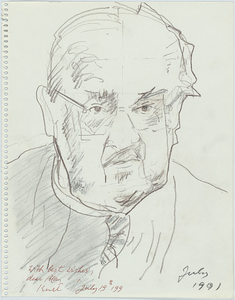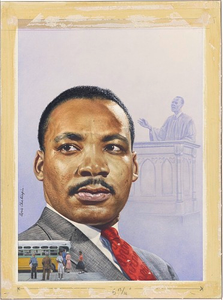Description
Born Baltimore, MarylandThurgood Marshall played a major role in the 1940s and 1950s as a leader in the struggle to end racial discrimination in the United States. From 1938 to 1961, he served as chief staff lawyer for the NAACP. Marshall devoted much effort to tailoring arguments that led the Supreme Court to its unanimous 1954 Brown v. the Board of Education of the City of Topeka decision, which ruled segregation of public schools by race to be unconstitutional. But he realized the struggle was not over. At a party celebrating the Brown decision, Marshall warned his colleagues, “I don’t want any of you to fool yourselves, it’s just begun; the fight has just begun.” He went on to become the first African American Supreme Court justice, nominated by President Lyndon Johnson in 1967.Nacido en Baltimore, MarylandThurgood Marshall tuvo un papel esencial en las décadas de 1940 y 1950 como líder en la lucha contra la discriminación racial en Estados Unidos. De 1938 a 1961 fue el abogado principal de la Asociación Nacional para el Progreso de las Personas de Color (NAACP en inglés), y como tal defendió a los demandantes en el caso Brown vs. Junta de Educación de la Ciudad de Topeka, formulando los argumentos que en 1954 llevaron al Tribunal Supremo a decidir por unanimidad que la segregación racial de las escuelas públicas era inconstitucional. No obstante, Marshall sabía que la lucha no había terminado. En una fiesta donde celebraban la decisión de Brown, advirtió a sus...
Image
Oil On Canvas
National Portrait Gallery, Smithsonian Institution; gift of the Harmon Foundation
Record Contributed By
National Portrait GalleryRecord Harvested From
Smithsonian InstitutionKeywords
- Activist
- Activists
- Civil Rights
- Civil Rights Activist
- Costume
- Facial Hair
- Jewelry
- Judge
- Judges
- Justice
- Law And Law Enforcement
- Lawyer
- Lawyers
- Male
- Marshall, Thurgood
- Men
- Mustache
- Mustaches
- Personal Attribute
- Portrait
- Portraits
- Presidential Medal Of Freedom
- Reformer
- Reformers
- Reyneau, Betsy Graves
- Ring
- Society And Social Change
- Thurgood Marshall
- Us Supreme Court Justice
- Wedding Band








![Lawyers Before Supreme Court (Hayes, Marshall Nabrit) [3963] Lawyers Before Supreme Court (Hayes, Marshall Nabrit) [3963]](https://d2l9jrtx1kk04i.cloudfront.net/8646f95fa73cc2d31ff76b3464f16ded959245ba.png)












